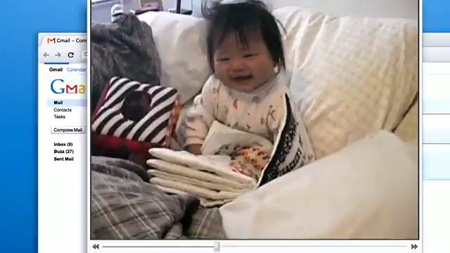Last May, to promote its Chrome browser, Google presented its hilarious spot showcasing weird but great speed tests, and now it switches from lab experiments to emotional components. The campaign dubbed ‘the Web is what you make of it’ was developed by Google in cooperation with the ad agency BBH New York, and starting Tuesday is rolling out on the U.S. television. “People are doing amazing things with the web, and our new series of films highlights some of these accomplishments, both big and small, serious and fun. The Web is What You Make of It. What would you make?” asks Google on its Chrome’s YouTube page.
NYTimes.com reported that, “Google captures two-thirds of online searches,” while, according to StatCounter, only about 18% of people use Chrome, launched in 2008, to surf the web, but it’s a good tendency—last year, the number Chrome users grew to 120 million from 40 million. This “biggest offline campaign ever for Google,” is aimed at attracting yet more people and expanding the community of Chrome users. “As people look for more cool and more interesting things on the Web, our business grows,” commented Andy Berndt, vice president of the Google Creative Lab.
The campaign is all about things people can do with the Chrome browser, no technical information, just the benefits put in a simple and engaging way. So far, Google released two 1:32-minute commercials, with the new ones to arrive in the coming weeks. One of the ads, launched on Tuesday, is called ‘Dear Sophie’ (Google says it’s based on real events) and is showing how Dad is creating a scrapbook for his daughter when she grows up—he’s making it in Gmail using services including Picasa, YouTube and Google Maps (he’s just pastes the images and videos into the letter). The second ad called ‘It Gets Better’ demonstrates how people use Chrome’s toolbar and YouTube to submit videos as part of It Gets Better Project aimed at supporting gay teens who face bullying. Viewers don’t see who actually types in and clicks—everything they see is only actions, which can be performed by just anyone who uses the browser.
The commercials finish with a link to the Google Chrome page—very simple but nice. “We try to get rid of everything but the user and the tools and let you feel what is happening there, without a lot of commentary from Google itself,” added Mr. Berndt. The campaign also includes online ads, white boxes, featuring simple scrolling calls such as “make a declaration,” “make an observation,” “make yourself heard” and “make a blog,” and after each ad there is a big button encouraging to “Switch to a new browser. Download Google Chrome.”
